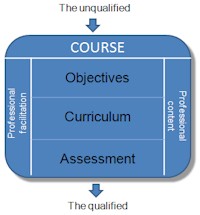![]() Throughout 2011 we will be publishing extracts from The New Learning Architect. We move on to the fifth part of chapter 4:
Throughout 2011 we will be publishing extracts from The New Learning Architect. We move on to the fifth part of chapter 4:

The goals of formal and non-formal learning are essentially the same – to equip employees with the fundamental knowledge and skills that they require to meet present and future job responsibilities. The difference is in the approach. The structure inherent in formal education, training and development – the objectives, the curricula, the assessment, the professional facilitation – provides advantages for employers and employees alike:
- Employers can have greater confidence that important content has been covered consistently.
- Employers can more easily track who has had what training and when.
- Employers can have greater confidence that learning objectives have actually been achieved.
- Employees can have greater confidence in the quality of the tuition they are likely to receive.
- Employees are more likely to have access to professionally-designed materials.
- Employees have the opportunity to gain a certification/qualification that will be valuable in their careers.
Coming next in chapter 4: The need for top-down learning
Return to Chapter 1 Chapter 2 Chapter 3
Obtain your copy of The New Learning Architect
